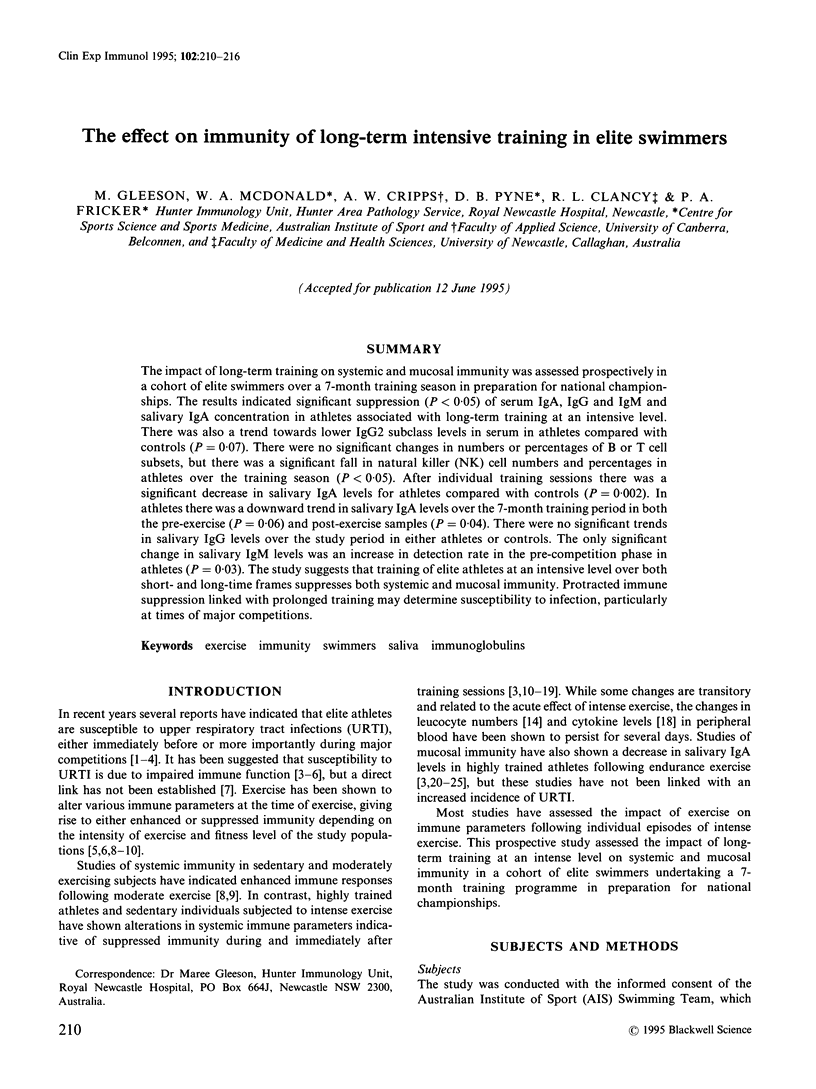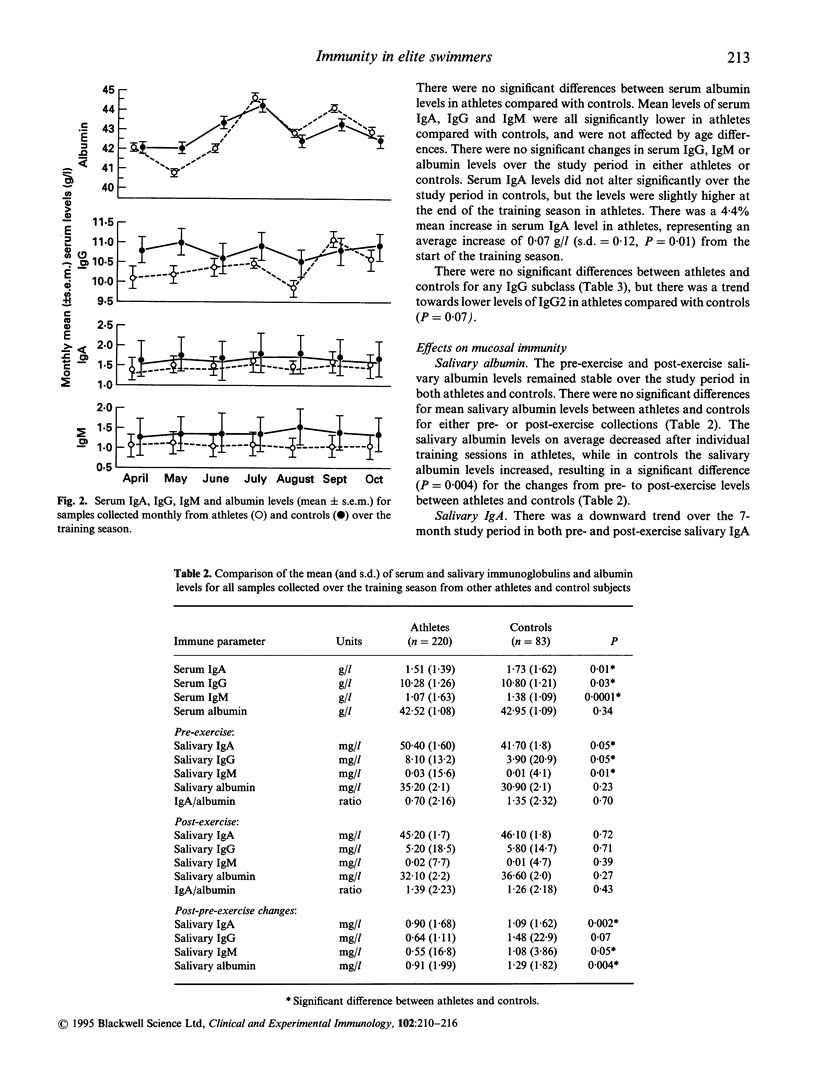Abstract
The impact of long-term training on systemic and mucosal immunity was assessed prospectively in a cohort of elite swimmers over a 7-month training season in preparation for national championships. The results indicated significant suppression (P < 0.05) of serum IgA, IgG and IgM and salivary IgA concentration in athletes associated with long-term training at an intensive level. There was also a trend towards lower IgG2 subclass levels in serum in athletes compared with controls (P = 0.07). There were no significant changes in numbers or percentages of B or T cell subsets, but there was a significant fall in natural killer (NK) cell numbers and percentages in athletes over the training season (P < 0.05). After individual training sessions there was a significant decrease in salivary IgA levels for athletes compared with controls (P = 0.002). In athletes there was a downward trend in salivary IgA levels over the 7-month training period in both the pre-exercise (P = 0.06) and post-exercise samples (P = 0.04). There were no significant trends in salivary IgG levels over the study period in either athletes or controls. The only significant change in salivary IgM levels was an increase in detection rate in the pre-competition phase in athletes (P = 0.03). The study suggests that training of elite athletes at an intensive level over both short- and long-time frames suppresses both systemic and mucosal immunity. Protracted immune suppression linked with prolonged training may determine susceptibility to infection, particularly at times of major competitions.
Full text
PDF






Selected References
These references are in PubMed. This may not be the complete list of references from this article.
- Bratthall D., Widerström L. Ups and downs for salivary IgA. Scand J Dent Res. 1985 Apr;93(2):128–134. doi: 10.1111/j.1600-0722.1985.tb01320.x. [DOI] [PubMed] [Google Scholar]
- Eskola J., Ruuskanen O., Soppi E., Viljanen M. K., Järvinen M., Toivonen H., Kouvalainen K. Effect of sport stress on lymphocyte transformation and antibody formation. Clin Exp Immunol. 1978 May;32(2):339–345. [PMC free article] [PubMed] [Google Scholar]
- Field C. J., Gougeon R., Marliss E. B. Circulating mononuclear cell numbers and function during intense exercise and recovery. J Appl Physiol (1985) 1991 Sep;71(3):1089–1097. doi: 10.1152/jappl.1991.71.3.1089. [DOI] [PubMed] [Google Scholar]
- Fry R. W., Morton A. R., Crawford G. P., Keast D. Cell numbers and in vitro responses of leucocytes and lymphocyte subpopulations following maximal exercise and interval training sessions of different intensities. Eur J Appl Physiol Occup Physiol. 1992;64(3):218–227. doi: 10.1007/BF00626284. [DOI] [PubMed] [Google Scholar]
- Gleeson M., Cripps A. W., Clancy R. L., Husband A. J., Hensley M. J., Leeder S. R. Ontogeny of the secretory immune system in man. Aust N Z J Med. 1982 Aug;12(4):255–258. doi: 10.1111/j.1445-5994.1982.tb03806.x. [DOI] [PubMed] [Google Scholar]
- Gmünder F. K., Joller P. W., Joller-Jemelka H. I., Bechler B., Cogoli M., Ziegler W. H., Müller J., Aeppli R. E., Cogoli A. Effect of a herbal yeast food supplement and long-distance running on immunological parameters. Br J Sports Med. 1990 Jun;24(2):103–112. doi: 10.1136/bjsm.24.2.103. [DOI] [PMC free article] [PubMed] [Google Scholar]
- Heath G. W., Ford E. S., Craven T. E., Macera C. A., Jackson K. L., Pate R. R. Exercise and the incidence of upper respiratory tract infections. Med Sci Sports Exerc. 1991 Feb;23(2):152–157. [PubMed] [Google Scholar]
- Hoffman-Goetz L., Pedersen B. K. Exercise and the immune system: a model of the stress response? Immunol Today. 1994 Aug;15(8):382–387. doi: 10.1016/0167-5699(94)90177-5. [DOI] [PubMed] [Google Scholar]
- Housh T. J., Johnson G. O., Housh D. J., Evans S. L., Tharp G. D. The effect of exercise at various temperatures on salivary levels of immunoglobulin A. Int J Sports Med. 1991 Oct;12(5):498–500. doi: 10.1055/s-2007-1024722. [DOI] [PubMed] [Google Scholar]
- Keast D., Cameron K., Morton A. R. Exercise and the immune response. Sports Med. 1988 Apr;5(4):248–267. doi: 10.2165/00007256-198805040-00004. [DOI] [PubMed] [Google Scholar]
- Mackinnon L. T., Chick T. W., van As A., Tomasi T. B. The effect of exercise on secretory and natural immunity. Adv Exp Med Biol. 1987;216A:869–876. doi: 10.1007/978-1-4684-5344-7_102. [DOI] [PubMed] [Google Scholar]
- Mackinnon L. T., Ginn E., Seymour G. J. Decreased salivary immunoglobulin A secretion rate after intense interval exercise in elite kayakers. Eur J Appl Physiol Occup Physiol. 1993;67(2):180–184. doi: 10.1007/BF00376664. [DOI] [PubMed] [Google Scholar]
- Nehlsen-Cannarella S. L., Nieman D. C., Balk-Lamberton A. J., Markoff P. A., Chritton D. B., Gusewitch G., Lee J. W. The effects of moderate exercise training on immune response. Med Sci Sports Exerc. 1991 Jan;23(1):64–70. [PubMed] [Google Scholar]
- Nieman D. C. Exercise, infection, and immunity. Int J Sports Med. 1994 Oct;15 (Suppl 3):S131–S141. doi: 10.1055/s-2007-1021128. [DOI] [PubMed] [Google Scholar]
- Nieman D. C., Nehlsen-Cannarella S. L. The effects of acute and chronic exercise of immunoglobulins. Sports Med. 1991 Mar;11(3):183–201. doi: 10.2165/00007256-199111030-00003. [DOI] [PubMed] [Google Scholar]
- Norhagen G., Engström P. E., Hammarström L., Söder P. O., Smith C. I. Immunoglobulin levels in saliva in individuals with selective IgA deficiency: compensatory IgM secretion and its correlation with HLA and susceptibility to infections. J Clin Immunol. 1989 Jul;9(4):279–286. doi: 10.1007/BF00918659. [DOI] [PubMed] [Google Scholar]
- Order U., Dufaux B., Uhlenbruck G., Liesen H. Lymphocyte subsets during the first hours and days after a 2.5 h running test. J Clin Lab Immunol. 1990 Jun;32(2):97–102. [PubMed] [Google Scholar]
- Pedersen B. K. Influence of physical activity on the cellular immune system: mechanisms of action. Int J Sports Med. 1991 Jun;12 (Suppl 1):S23–S29. doi: 10.1055/s-2007-1024746. [DOI] [PubMed] [Google Scholar]
- Pedersen B. K., Tvede N., Hansen F. R., Andersen V., Bendix T., Bendixen G., Bendtzen K., Galbo H., Haahr P. M., Klarlund K. Modulation of natural killer cell activity in peripheral blood by physical exercise. Scand J Immunol. 1988 Jun;27(6):673–678. doi: 10.1111/j.1365-3083.1988.tb02400.x. [DOI] [PubMed] [Google Scholar]
- Peters E. M., Bateman E. D. Ultramarathon running and upper respiratory tract infections. An epidemiological survey. S Afr Med J. 1983 Oct 1;64(15):582–584. [PubMed] [Google Scholar]
- Shephard R. J., Rhind S., Shek P. N. Exercise and the immune system. Natural killer cells, interleukins and related responses. Sports Med. 1994 Nov;18(5):340–369. doi: 10.2165/00007256-199418050-00006. [DOI] [PubMed] [Google Scholar]
- Sprenger H., Jacobs C., Nain M., Gressner A. M., Prinz H., Wesemann W., Gemsa D. Enhanced release of cytokines, interleukin-2 receptors, and neopterin after long-distance running. Clin Immunol Immunopathol. 1992 May;63(2):188–195. doi: 10.1016/0090-1229(92)90012-d. [DOI] [PubMed] [Google Scholar]
- Tharp G. D., Barnes M. W. Reduction of saliva immunoglobulin levels by swim training. Eur J Appl Physiol Occup Physiol. 1990;60(1):61–64. doi: 10.1007/BF00572187. [DOI] [PubMed] [Google Scholar]
- Tomasi T. B., Trudeau F. B., Czerwinski D., Erredge S. Immune parameters in athletes before and after strenuous exercise. J Clin Immunol. 1982 Jul;2(3):173–178. doi: 10.1007/BF00915219. [DOI] [PubMed] [Google Scholar]


